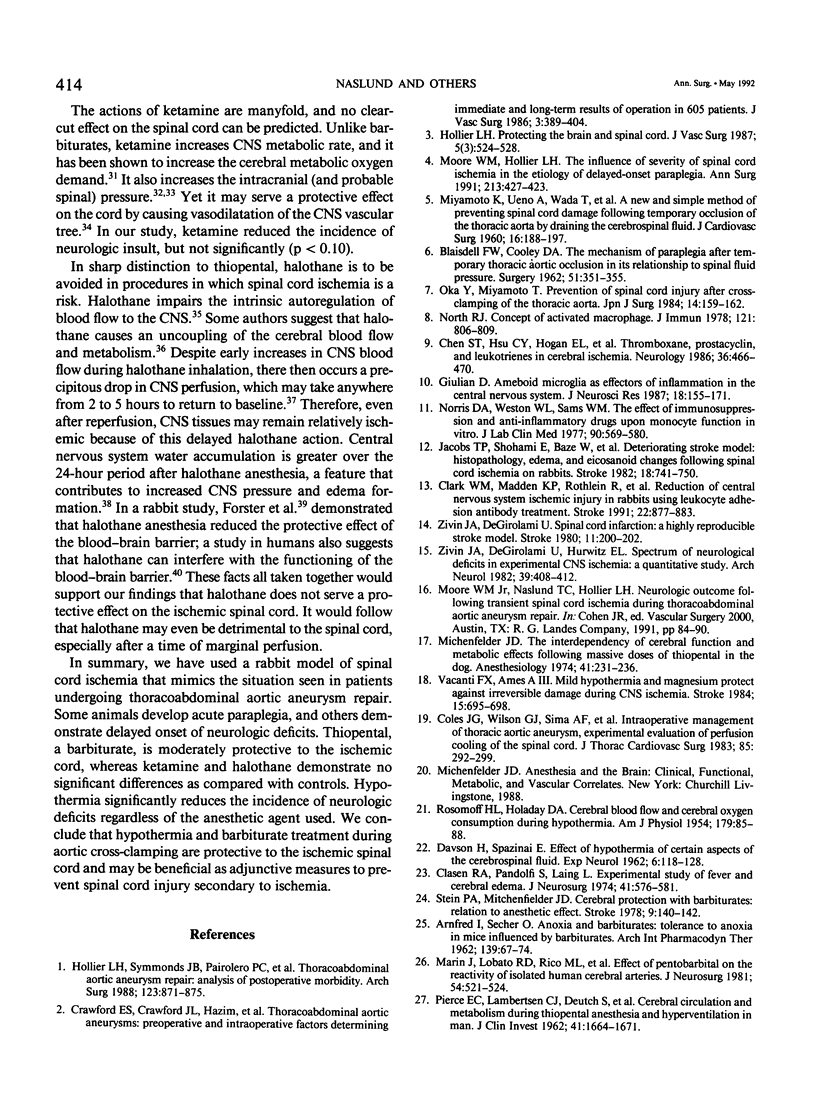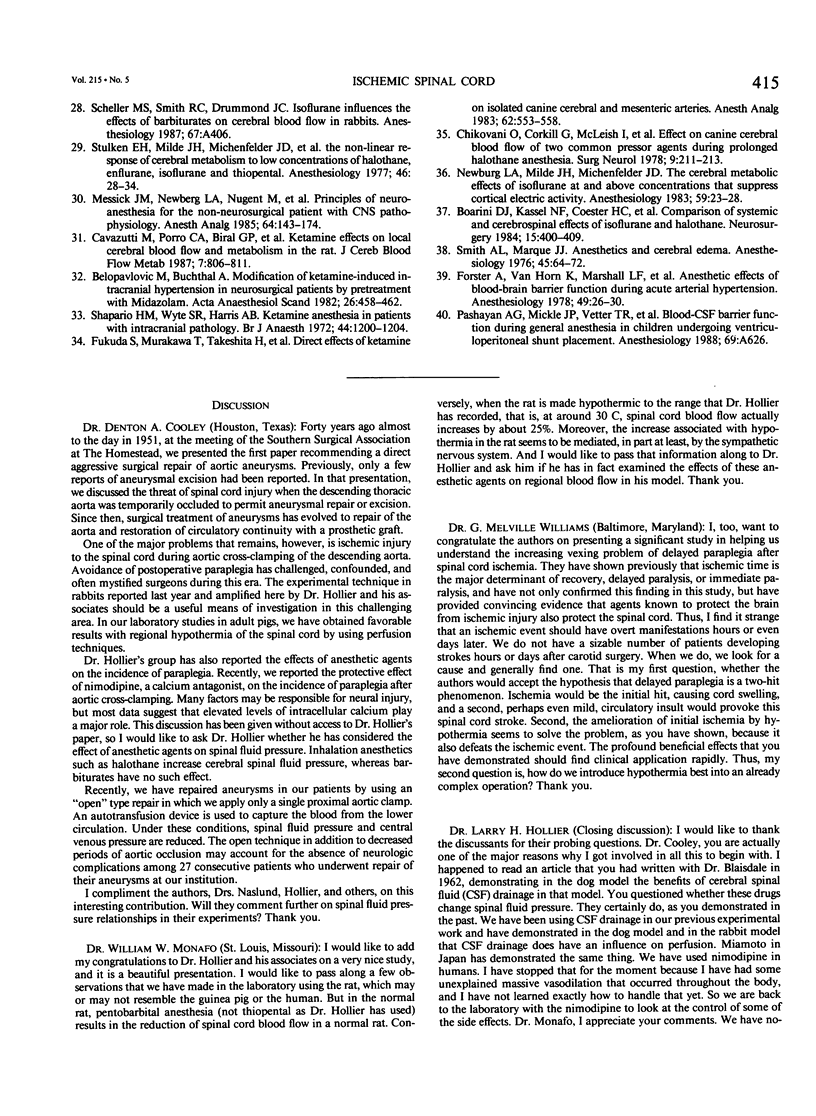Abstract
Infrarenal circumaortic occlusion devices were operatively placed in 74 New Zealand white rabbits. Two days after operation the animals were randomly assigned to one of seven treatment groups: I, control, n = 23; II, halothane, n = 8; III, thiopental, n = 12; IV, ketamine (30 mg/kg intravenously), n = 6; V, halothane+hypothermia, n = 8; VI, thiopental+hypothermia, n = 12; VII, ketamine+hypothermia, n = 5. In each group, the infrarenal aorta was occluded for 21 minutes. Final neurologic recovery after restitution of blood flow was graded as acute paraplegia, delayed paraplegia (neurologic deficit developing after initial recovery), or normal. Halothane alone was of no benefit. Hypothermia with any anesthetic was completely protective and reduced neurologic deficits to 0% compared with 91% in controls (p less than 0.05). Thiopental and ketamine treatment each reduced acute paraplegia to 17% (as compared with 61% in controls) and increased delayed paraplegia from 30% in controls to 75% and 50%, respectively (p less than 0.05 for thiopental, p = 0.10 for ketamine). The authors interpret the increase in delayed deficits and decrease in acute deficits as being the result of partial spinal cord protection. These findings document that this model of spinal cord ischemia is sufficiently sensitive to identify interventional treatments that protect the ischemic spinal cord.
Full text
PDF






Images in this article
Selected References
These references are in PubMed. This may not be the complete list of references from this article.
- BLAISDELL F. W., COOLEY D. A. The mechanism of paraplegia after temporary thoracic aortic occlusion and its relationship to spinal fluid pressure. Surgery. 1962 Mar;51:351–355. [PubMed] [Google Scholar]
- Belopavlovic M., Buchthal A. Modification of ketamine-induced intracranial hypertension in neurosurgical patients by pretreatment with midazolam. Acta Anaesthesiol Scand. 1982 Oct;26(5):458–462. doi: 10.1111/j.1399-6576.1982.tb01799.x. [DOI] [PubMed] [Google Scholar]
- Boarini D. J., Kassell N. F., Coester H. C., Butler M., Sokoll M. D. Comparison of systemic and cerebrovascular effects of isoflurane and halothane. Neurosurgery. 1984 Sep;15(3):400–409. doi: 10.1227/00006123-198409000-00017. [DOI] [PubMed] [Google Scholar]
- Cavazzuti M., Porro C. A., Biral G. P., Benassi C., Barbieri G. C. Ketamine effects on local cerebral blood flow and metabolism in the rat. J Cereb Blood Flow Metab. 1987 Dec;7(6):806–811. doi: 10.1038/jcbfm.1987.138. [DOI] [PubMed] [Google Scholar]
- Chen S. T., Hsu C. Y., Hogan E. L., Halushka P. V., Linet O. I., Yatsu F. M. Thromboxane, prostacyclin, and leukotrienes in cerebral ischemia. Neurology. 1986 Apr;36(4):466–470. doi: 10.1212/wnl.36.4.466. [DOI] [PubMed] [Google Scholar]
- Chikovani O., Corkill G., McLeish I., Ong S., Beilin D. Effect on canine cerebral blood flow of two common pressor agents during prolonged halothane anesthesia. Surg Neurol. 1978 Mar;9(3):211–213. [PubMed] [Google Scholar]
- Clark W. M., Madden K. P., Rothlein R., Zivin J. A. Reduction of central nervous system ischemic injury in rabbits using leukocyte adhesion antibody treatment. Stroke. 1991 Jul;22(7):877–883. doi: 10.1161/01.str.22.7.877. [DOI] [PubMed] [Google Scholar]
- Clasen R. A., Pandolfi S., Laing I., Casey D., Jr Experimental study of relation of fever to cerebral edema. J Neurosurg. 1974 Nov;41(5):576–581. doi: 10.3171/jns.1974.41.5.0576. [DOI] [PubMed] [Google Scholar]
- Coles J. G., Wilson G. J., Sima A. F., Klement P., Tait G. A., Williams W. G., Baird R. J. Intraoperative management of thoracic aortic aneurysm. Experimental evaluation of perfusion cooling of the spinal cord. J Thorac Cardiovasc Surg. 1983 Feb;85(2):292–299. [PubMed] [Google Scholar]
- Crawford E. S., Crawford J. L., Safi H. J., Coselli J. S., Hess K. R., Brooks B., Norton H. J., Glaeser D. H. Thoracoabdominal aortic aneurysms: preoperative and intraoperative factors determining immediate and long-term results of operations in 605 patients. J Vasc Surg. 1986 Mar;3(3):389–404. doi: 10.1067/mva.1986.avs0030389. [DOI] [PubMed] [Google Scholar]
- DAVSON H., SPAZIANI E. Effect of hypothermia on certain aspects of the cerebrospinal fluid. Exp Neurol. 1962 Aug;6:118–128. doi: 10.1016/0014-4886(62)90082-1. [DOI] [PubMed] [Google Scholar]
- Forster A., Van Horn K., Marshall L. F., Shapiro H. M. Anesthetic effects on blood-brain barrier function during acute arterial hypertension. Anesthesiology. 1978 Jul;49(1):26–30. doi: 10.1097/00000542-197807000-00008. [DOI] [PubMed] [Google Scholar]
- Fukuda S., Murakawa T., Takeshita H., Toda N. Direct effects of ketamine on isolated canine cerebral and mesenteric arteries. Anesth Analg. 1983 Jun;62(6):553–558. [PubMed] [Google Scholar]
- Giulian D. Ameboid microglia as effectors of inflammation in the central nervous system. J Neurosci Res. 1987;18(1):155-71, 132-3. doi: 10.1002/jnr.490180123. [DOI] [PubMed] [Google Scholar]
- Hollier L. H. Protecting the brain and spinal cord. J Vasc Surg. 1987 Mar;5(3):524–528. doi: 10.1067/mva.1987.avs0050524. [DOI] [PubMed] [Google Scholar]
- Hollier L. H., Symmonds J. B., Pairolero P. C., Cherry K. J., Hallett J. W., Gloviczki P. Thoracoabdominal aortic aneurysm repair. Analysis of postoperative morbidity. Arch Surg. 1988 Jul;123(7):871–875. doi: 10.1001/archsurg.1988.01400310085014. [DOI] [PubMed] [Google Scholar]
- Jacobs T. P., Shohami E., Baze W., Burgard E., Gunderson C., Hallenbeck J. M., Feuerstein G. Deteriorating stroke model: histopathology, edema, and eicosanoid changes following spinal cord ischemia in rabbits. Stroke. 1987 Jul-Aug;18(4):741–750. doi: 10.1161/01.str.18.4.741. [DOI] [PubMed] [Google Scholar]
- MIYAMOTO K., UENO A., WADA T., KIMOTO S. A new and simple method of preventing spinal cord damage following temporary occlusion of the thoracic aorta by draining the cerebrospinal fluid. J Cardiovasc Surg (Torino) 1960 Sep;1:188–197. [PubMed] [Google Scholar]
- Marín J., Lobato R. D., Rico M. L., Salaices M., Benitez J. Effect of pentobarbital on the reactivity of isolated human cerebral arteries. J Neurosurg. 1981 Apr;54(4):521–524. doi: 10.3171/jns.1981.54.4.0521. [DOI] [PubMed] [Google Scholar]
- Messick J. M., Jr, Newberg L. A., Nugent M., Faust R. J. Principles of neuroanesthesia for the nonneurosurgical patient with CNS pathophysiology. Anesth Analg. 1985 Feb;64(2):143–174. [PubMed] [Google Scholar]
- Michenfelder J. D. The interdependency of cerebral functional and metabolic effects following massive doses of thiopental in the dog. Anesthesiology. 1974 Sep;41(3):231–236. doi: 10.1097/00000542-197409000-00004. [DOI] [PubMed] [Google Scholar]
- Moore W. M., Jr, Hollier L. H. The influence of severity of spinal cord ischemia in the etiology of delayed-onset paraplegia. Ann Surg. 1991 May;213(5):427–432. doi: 10.1097/00000658-199105000-00007. [DOI] [PMC free article] [PubMed] [Google Scholar]
- Newberg L. A., Milde J. H., Michenfelder J. D. The cerebral metabolic effects of isoflurane at and above concentrations that suppress cortical electrical activity. Anesthesiology. 1983 Jul;59(1):23–28. doi: 10.1097/00000542-198307000-00005. [DOI] [PubMed] [Google Scholar]
- Norris D. A., Weston W. L., Sams W. M., Jr The effect of immunosuppressive and anti-inflammatory drugs on monocyte function in vitro. J Lab Clin Med. 1977 Sep;90(3):569–580. [PubMed] [Google Scholar]
- North R. J. The concept of the activated macrophage. J Immunol. 1978 Sep;121(3):806–809. [PMC free article] [PubMed] [Google Scholar]
- Oka Y., Miyamoto T. Prevention of spinal cord injury after cross-clamping of the thoracic aorta. Jpn J Surg. 1984 Mar;14(2):159–162. doi: 10.1007/BF02469810. [DOI] [PubMed] [Google Scholar]
- PIERCE E. C., Jr, LAMBERTSEN C. J., DEUTSCH S., CHASE P. E., LINDE H. W., DRIPPS R. D., PRICE H. L. Cerebral circulation and metabolism during thiopental anesthesia and hyper-ventilation in man. J Clin Invest. 1962 Aug;41:1664–1671. doi: 10.1172/JCI104623. [DOI] [PMC free article] [PubMed] [Google Scholar]
- ROSOMOFF H. L., HOLADAY D. A. Cerebral blood flow and cerebral oxygen consumption during hypothermia. Am J Physiol. 1954 Oct;179(1):85–88. doi: 10.1152/ajplegacy.1954.179.1.85. [DOI] [PubMed] [Google Scholar]
- Shaprio H. M., Wyte S. R., Harris A. B. Ketamine anaesthesia in patients with intracranial pathology. Br J Anaesth. 1972 Nov;44(11):1200–1204. doi: 10.1093/bja/44.11.1200. [DOI] [PubMed] [Google Scholar]
- Smith A. L., Marque J. J. Anesthetics and cerebral edema. Anesthesiology. 1976 Jul;45(1):64–72. doi: 10.1097/00000542-197607000-00012. [DOI] [PubMed] [Google Scholar]
- Steen P. A., Michenfelder J. D. Cerebral protection with barbiturates: relation to anesthetic effect. Stroke. 1978 Mar-Apr;9(2):140–142. doi: 10.1161/01.str.9.2.140. [DOI] [PubMed] [Google Scholar]
- Stullken E. H., Jr, Milde J. H., Michenfelder J. D., Tinker J. H. The nonlinear responses of cerebral metabolism to low concentrations of halothane, enflurane, isoflurane, and thiopental. Anesthesiology. 1977 Jan;46(1):28–34. doi: 10.1097/00000542-197701000-00007. [DOI] [PubMed] [Google Scholar]
- Vacanti F. X., Ames A., 3rd Mild hypothermia and Mg++ protect against irreversible damage during CNS ischemia. Stroke. 1984 Jul-Aug;15(4):695–698. doi: 10.1161/01.str.15.4.695. [DOI] [PubMed] [Google Scholar]
- Zivin J. A., DeGirolami U., Hurwitz E. L. Spectrum of neurological deficits in experimental CNS ischemia. A quantitative study. Arch Neurol. 1982 Jul;39(7):408–412. doi: 10.1001/archneur.1982.00510190026008. [DOI] [PubMed] [Google Scholar]
- Zivin J. A., DeGirolami U. Spinal cord infarction: a highly reproducible stroke model. Stroke. 1980 Mar-Apr;11(2):200–202. doi: 10.1161/01.str.11.2.200. [DOI] [PubMed] [Google Scholar]





